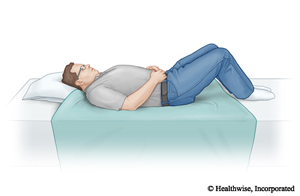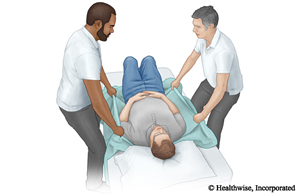Why is it important to turn a person in bed?
People sometimes have to stay in bed for long periods of time. And they may not be able to move themselves into different positions. It's very important that a person changes positions. Lying in one position for a long time can cause pressure injuries (also called pressure sores).
Pressure injuries are damage to the skin. They can range from red areas on the surface of the skin to severe tissue damage that goes deep into muscle and bone. These problems are hard to treat and slow to heal. When pressure injuries don't heal well, they can cause problems such as bone, blood, and skin infections.
Pressure injuries usually occur over bony areas, such as the hips, lower back, elbows, heels, and shoulders. They can also occur in places where the skin folds over on itself.
You can help a person avoid pressure injuries by helping them turn and change position in bed. A drawsheet can help.
Positioning a drawsheet

- When you make someone's bed with a drawsheet, position it so that it is between the person's head and knees.
How do you turn a person in bed?
Before getting started, tell the person that you want them to roll into another position. If they have any drains, tubes, or other medical equipment, adjust these so they don't get in the way.
If the person can help
- You may need to help the person scoot toward the opposite side of the bed so that they will have room to roll.
- Go to the side of the bed you want them to roll toward.
- Ask them to lie on their back with the knees bent. Have them place their arms across the body.
- Ask them to roll toward you while keeping the knees bent. If you have a rail on the bed, have them reach toward the rail.
- Help them as needed. Gently place your hands on the shoulders and hips, and guide the person toward you.
If the person can't help
It is best to turn the person every 2 hours. If they cannot move or find it very hard, you can use your drawsheet (see "What is a drawsheet?").
Have a family member or friend help you. It is easier for two people to turn someone, and it can be dangerous for one person to do it.
Position the person
- You and your assistant will stand on opposite sides of the bed. If the person is in a hospital bed, lower the height of the bed. This will make it easier to turn the person.
- Untuck the drawsheet on both sides of the bed. You and your assistant will gather up one side of the drawsheet so you both almost have a "handle" to grab. You may also need to make sure the person is high enough up in the bed. If not, lift them toward the head of the bed.
- Agree on a count, and then lift and move them to the side of the bed you're going to roll away from.
- Tuck in the drawsheet on the side of the bed that they will roll toward.
- When you make someone's bed with a drawsheet, position it so that it is between the person's head and knees.

- The drawsheet can then be used to turn or move the person you're caring for.

Move the person
When you and your assistant are ready:
- Help the person lie on their back with the knees bent. If they can't bend the knees, cross one ankle over the other in the direction of the turn. Position their arms across their body.
- Stand on opposite sides of the bed. One of you will pull, and the other will push. Be sure that you and your assistant have your feet shoulder-width apart. This will help you avoid straining your back.
- If you're pulling the person toward you, lean from your hips (don't bend your back), reach over the person, and grab the drawsheet at their hip and shoulder areas. Slowly pull the drawsheet toward you to roll the person over.
- If you're rolling them away from you, slowly push at the hip and shoulder areas.
Moving someone in bed is best as a two-person job. If the person can help, even a little, you may be able to do it yourself. But if you can, find someone to help you.
What do you do after turning someone?
You can use pillows to help the person get comfortable and avoid pressure injuries.
If the person is on their side:
- Place pillows in front of them, at chest level, with the top arm draped over a pillow.
- If needed, tuck one edge of a pillow under the buttock, lengthwise. Then fold the pillow under and tuck the other edge under the first edge. That creates a "roll" that stays in place better and helps keep the person from rolling back.
- Place a pillow between the person's knees, with the legs slightly bent.
- Put the top leg a little in front of the bottom leg. This takes pressure off the bottom leg.
- Put a pillow under the bottom leg so that the bottom ankle is off the bed.
If the person is on their back:
- Put a pillow under their legs between the knees and ankles.
- Do not put anything under the heels.
- If you have a hospital bed, don't adjust the top end above 30 degrees. This helps prevent the person from sliding down.
When you are finished, smooth out the drawsheet in its original position and tuck it in.
Where can you learn more?
Go to https://www.healthwise.net/patientEd
Enter Y934 in the search box to learn more about "Learning About Turning a Person in Bed".
